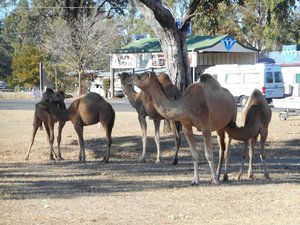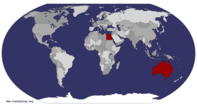Advertisement
Published: August 15th 2014

 Camels Come to Town
Camels Come to Town
I was surprised to see these camels feeding their young in the middle of Sapphire. Another group of inhabitants on the Miners Common.Early in the morning I heard some strange grunting outside the van and thought it may be kangaroos or the cattle (though it didn’t sound bovine). I didn’t bother to investigate but just went back to sleep. Then, as I was dressing around 8.30am, I saw a camel cross the main road. I couldn’t believe my eyes, so I grabbed my camera and went to see if I’d seen correctly. Sure enough, just down the road in the middle of the town, I saw a mob of cows on one corner and a mob of camels on the opposite corner. The camels were all females, most with young who were suckling. Once they’d finished feeding, they started to cross the main road at the same place that the cattle had yesterday. They sauntered along and, when a couple of cars arrived and started to drive around them, they straightened up and walked down the road on one side instead, heading towards the end of town. They, it seems, do have some road sense.
I came back for breakfast, and afterward, when Barry took the video camera over to film them they’d vanished. He got talking to a man who was

 More Road Sense That Cattle
More Road Sense That Cattle
When the camels moved off they noticed the cars approaching and changed direction to walk along the road instead of across it as the cattle had yesterday. People still just drive around them.filling a large tank from the Public Water Point across the road from the camp site. It cost $5 for 1,000 litres, paid at the pump. He was a miner with a claim 14 kms out of Sapphire and had some tanks for water on his site, which held about 6,000 litres. When he ran out he would come into town and fill his tank on the back of his small tray truck, then take it back and pump it into his home tanks. He would do the run six times, with a 28 km round trip each time, until they were full again. It would have taken him all day! He’d lived there for seven years, so that was a lot of driving for water! He also warned Barry not to drink the water unless it was boiled or had been left in the open for four days because it was artesian water that had been treated with chlorine. Unfortunately, when a lot of people drew on the water, the chlorine became concentrated and would make you sick. Let’s hope we don’t need to use it!
After that we set off to Rubyvale, 6 kms up the road.

 The Rescued Gecko
The Rescued Gecko
This little Northern Spiny-tailed Gecko was roaming around in the Rubyvale Miners Heritage Walk-In Sapphire Mine when we did the underground tour. Barry picked it up as we were leaving to take back to the surface where he could find food.It is bigger than Sapphire and even has a Post Office, Pub, and three cafes. There were also lots of shops selling sapphires, of course. We headed straight up to the Miners Heritage Walk-In Mine Tour (as recommended by Barry’s miner friend) and booked in for us both to do the tour for $17.50 each (Seniors rate). We had a look around their shop while we waited for the next one and saw most of the same things we’d seen at McArthurs, just more of them.
At quarter past, our tour guide took us down some steps and into the underground mine, which was started in the early 1900s. The old part of the mine showed the conditions that miners worked in during those days, especially the very low tunnels. We were told that the wash level that bears the gems usually sits on a granite bedrock because it is the stones from a river bed that has settled there. Sapphires, being very heavy, usually dropped to the bottom of the river. When you had to dig all the soil out by hand, in candle light, as they did in those days, they only dig what they have to

 A Hard Working Miner
A Hard Working Miner
This figure was part of the display in the Rubyvale Miners Heritage Walk-In Sapphire Mine. He is demonstrating the use of a sieve to separate the gems from the dirt.so they produce a shaft and hope they hit the wash. Then they just dig along the wash level and remove it, which can be quite thin. They would drag it to the shaft and have a partner up top who would haul it up to be washed and sorted later. The further into the mine they dug, the less air was available so they would hope that their partner was still up there when the candle started to go out and they crawled out of the tunnel, gasping as they went! They used a very short handled pick to dig as there was hardly any room to swing it.
Many mines later became open cut, because it was much easier to use mechanical diggers to remove the wash and the rubbish that was on top. The Department of Mines decided to set aside some areas of the gem fields to only allow hand mining.
Miners now use jack hammers or digging machines, rather like mechano, with two levers behind that operate it, to do the digging. These evidently still qualify as hand digging, not mechanical, as their feet are still on the ground.
The wash or

 Wifi and Strudel
Wifi and Strudel
Barry making use of the free WiFi at the Strudel Hut where we had just enjoyed some wonderful home-made strudel amid the peaceful and cool shade of their garden. It was a wonderful interlude on a hot tiring day.rubble is taken to the bucket and lifted up the shaft where it is tipped over the top into a hopper to be washed. Machines, called “Wash Plants”, now do all this automatically, and then shake off the excess dirt and rinse the wash to clean it while bumping it up and down to shake the heavy stones, such as Sapphire, Zircon, Spinel and Ironstone, to the centre. This heavy material, or “concentrate” is put into a bin for the miner to sort later, while the lighter stuff is discarded. This is also what is sold as wash here.
Our guide showed us some of the early equipment and we saw some raw sapphires still embedded in the soil. She also told us that the most common colours in the region are the rich blue, the yellows and the greens, although the Central Queensland Gemfields have the largest range of colours in the world due to the unusual mineralisation in the soil. The golden yellow and orange are very rare and as such more valuable and rubies are almost unknown in the area. Some of the stones have two colours, usually yellow and blue, and are called parti-colours.

 A Wash Plant
A Wash Plant
The stone wash is put into the machine and shaken to remove the dirt, then sieved to separate the heavy material like gems, if any.A miner then goes through what has been caught to find any gemstones.While we were watching a DVD of the operating mine (they cannot legally take you into a working mine any more) we spotted a small gecko who had made his way down there. On the way back out Barry looked for it again and caught it so he could take it back up to the surface as it would die down there.
At the end of the tour we went into a small museum room and read some news stories of the most famous finds from the area and some of the characters who mined them. Then Barry went outside and found a good tree stump to release the gecko on (I found out later he was a Northern Spiny-tailed Gecko).
After that we went back into the shop and bought a bag of wash for $20. They use a slightly different method for processing the wash here than in NSW. The first sieving is done dry and in only one fine sieve (rather than the two – one large and one small sized holes on top of each other.) The trick is doing the bouncing of the sieve in the water correctly so it shakes the rubbish to the edges. We never did manage to do it properly. They then tip the contents onto a special metal table for sorting. The rubbish is then brushed off into a wheel barrow with a scrubbing brush. We enjoyed ourselves, although it did get a bit hot in the sun. Unfortunately, you need the bright sun to see the sparkle of the sapphires so you just have to put up with it.
We managed to find a few small stones and some zircons, even one little red one. One of the shop assistants took them to a strong light and checked them for being gem quality, but, of course, none were. Never mind, we’d enjoyed it and we have a lovely memento of the day.
We then realised it was getting on for 3pm and we hadn’t eaten yet, so we looked for the Strudel Hut we’d seen in the brochures. It was set in a lovely garden with lots of shade, water fountains and pools, with characters hanging about them, like a crocodile, a goanna and a koala abseiling down a rope. Best of all was the lovely iced coffees, scones and strudel, apple for Barry and cherry for me, all home made by the German man who served us. It was really lovely and cool and we felt very refreshed after it. Barry also used their free Wifi to download some tablet and i-phone updates, so he was doubly happy.
We stopped for a look in a couple of the gem shops, including the Rubyvale Gem Gallery, where I saw an amazingly large golden yellow sapphire in a ring, on sale for $95,000!
On the way out of Rubyvale we were stopped by some more cattle on the common and then, as we entered our camp ground in Sapphire, the Guinea Fowl got in the way! The animals definitely win around here!
Advertisement
Tot: 0.101s; Tpl: 0.019s; cc: 13; qc: 53; dbt: 0.0567s; 1; m:domysql w:travelblog (10.17.0.13); sld: 1;
; mem: 1.1mb










